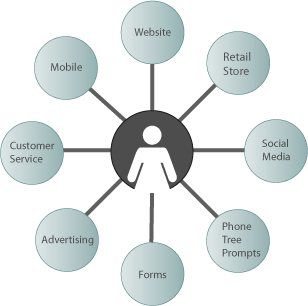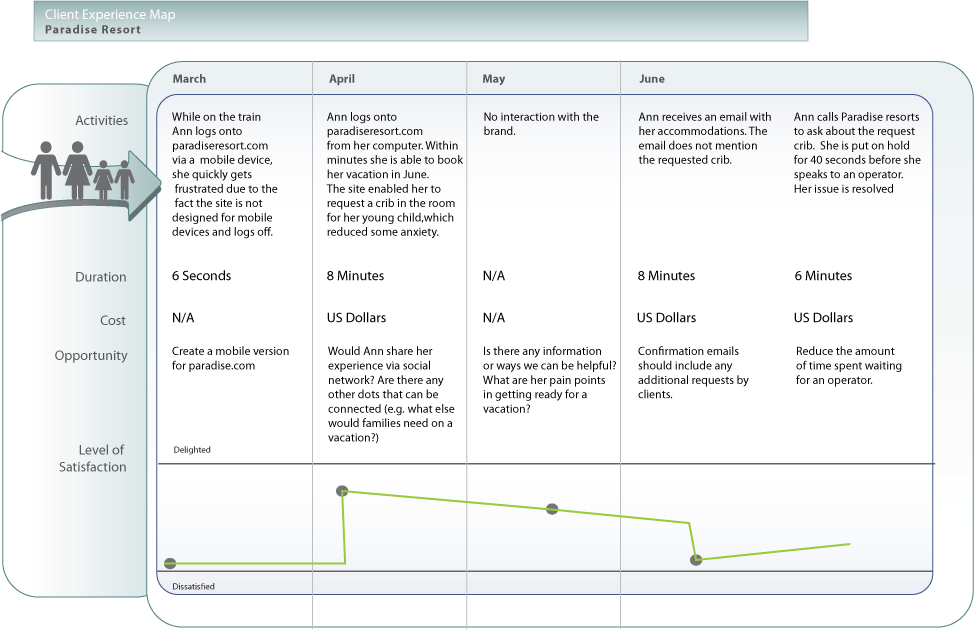An experience map is a holistic view of all of the touchpoints or interactions people have with a brand. It enables you to determine a number of key factors:
- Frequency and duration of each touchpoint
- Levels of satisfaction with each touchpoint
- Points of failure or bad experiences
- Opportunities to innovate during the experience
- A foundation for determining the cost of each touchpoint
Why Create an Experience Map?
The map helps stakeholders empathize with their customers, putting them in their customers’ shoes. It visualizes the journey of what their customers go through.

Most of the impressions or experiences people have with brands are made up of multiple interactions. For example, when we interact with a resort hotel a few of the touchpoints may be:
- A website for booking a room
- A call center if we have additional questions or problems
- A person who greets us at the front desk when we check in
- The time it takes to check in
- The ease of finding the room
- The cleanliness and amenities of the room
- The friendliness and responsiveness of the resort staff
How to Create an Experience Map
The first step is to segment the audience. Let’s continue the earlier example of the resort, and segment the audience into two groups:
- Business travelers
- Families on vacation
Determine the goals, pain points, and level of importance of each touchpoint for each group. This can be accomplished by both qualitative and quantitative research.
Document the experience of each touchpoint over time. Depending on the type of business, the timeframe and difficulty will vary. For example, a high-touch experience like a restaurant could be documented in minutes. A low-touch experience like a software company with a few products and an annual conference can be documented over the course of a year.
Points to capture in the map
- The frequency of each interaction – This helps identify missed opportunities. For example, you may notice a pattern that clients do not interact with the brand during certain times, days, or months.
- The duration of each interaction – This gives insight into the client’s level of satisfaction, and identifies inefficiencies and opportunities to innovate.
- The levels of satisfaction – This guides where to invest resources.
- Points of failure or inefficiencies – This guides where to invest resources.
- Opportunities to innovate – Identify areas to improve the experience.
- Determining the cost of each touchpoint – This identifies inefficiencies and opportunities for innovation. The process of determining the cost of each touchpoint is too complex to cover in this article.
Benefits of Creating an Experience Map
I have used experience maps several times on projects. On one project, we redesigned a claim form for an insurance company. Documenting the customer’s entire experience led us to examine the call center, and we found inefficiencies in the way calls were handled. We also discovered that the information the call center would request from customers was either unavailable or difficult to locate on the form, which was valuable information for the redesign.
On another project, we looked at the experience of an entire year’s worth of communications between a company and its customers. The experience map enabled us to see that there were months of no communication, and that most interactions customers had with the company were around resolving bills. This information led to the restructuring of how the company communicated with its customers.
Experience maps are useful in visualizing how each interaction combines to create the overall experience. By seeing the big picture, you can identify inefficiencies and opportunities for innovation to improve the overall experience. One poor interaction can result in a bad experience and dilute brand equity. Since experiences are a result of multiple interactions, nothing should be left to chance.








